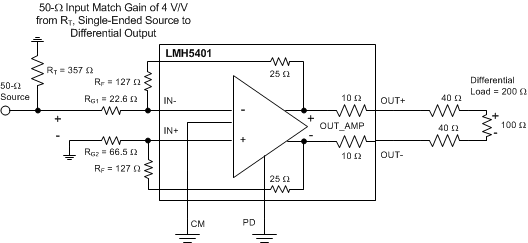SBOS710D October 2014 – February 2018 LMH5401
PRODUCTION DATA.
- 1 Features
- 2 Applications
- 3 Description
- 4 Revision History
- 5 Pin Configuration and Functions
-
6 Specifications
- 6.1 Absolute Maximum Ratings
- 6.2 ESD Ratings
- 6.3 Recommended Operating Conditions
- 6.4 Thermal Information
- 6.5 Electrical Characteristics: VS = 5 V
- 6.6 Electrical Characteristics: VS = 3.3 V
- 6.7 Typical Characteristics: 5 V
- 6.8 Typical Characteristics: 3.3 V
- 6.9 Typical Characteristics: 3.3-V to 5-V Supply Range
- 7 Parameter Measurement Information
- 8 Detailed Description
-
9 Application and Implementation
- 9.1 Application Information
- 9.2 Typical Application
- 9.3 Do's and Don'ts
- 10Power Supply Recommendations
- 11Layout
- 12Device and Documentation Support
- 13Mechanical, Packaging, and Orderable Information
Package Options
Mechanical Data (Package|Pins)
- RMS|14
Thermal pad, mechanical data (Package|Pins)
Orderable Information
8.3.2.2 DC-Coupled Input Signal Path Considerations for SE-DE Conversions
The output considerations remain the same as for the AC-coupled design. The input can be DC-coupled when the output is AC-coupled. A DC-coupled input with an AC-coupled output can have some advantages to move the input VICM down if the source is ground referenced. When the source is DC-coupled into the LMH5401 (as shown in Figure 60), both sides of the input circuit must be DC coupled to retain differential balance. Normally, the non-signal input side has an RG element biased to an expected source midrange value. Providing this midscale reference provides a balanced differential swing around VOCM at the outputs. Often, RG2 is grounded for DC-coupled, bipolar-input applications. This configuration provides a balanced differential output if the source swings around ground. If the source swings from ground to some positive voltage, grounding RG2 results in a unipolar output differential swing from both outputs at VOCM (when the input is at ground) to one polarity of swing. Biasing RG2 to an expected midpoint for the input signal creates a differential output swing around VOCM. One significant consideration for a DC-coupled input is that VOCM sets up a common-mode bias current from the output back through RF and RG to the source on both sides of the feedback. Without input-balancing networks, the source must sink or source this DC current. After the input signal range and biasing on the other RG element is set, check that the voltage divider from VOCM to VI through RF and RG (and possibly RS) establishes an input VICM at the device input pins that is in range.
 Figure 60. DC-Coupled, Single-Ended-to-Differential, Gain of 4 V/V
Figure 60. DC-Coupled, Single-Ended-to-Differential, Gain of 4 V/V